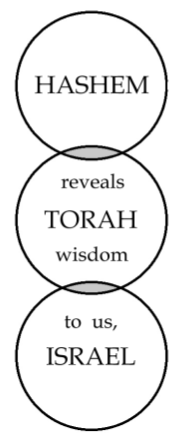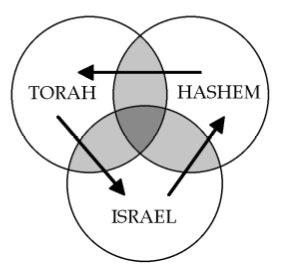The holiday of Shavuot is a celebration of the ‘Giving of the Torah at Mount Sinai’— when infinite Divine intelligence was revealed within the finite world of time and space.
When this intelligence first entered the world, it was an utterly simple seed: the entire Torah was encapsulated within the Alef, the first letter of the first word revealed at Sinai. This is called the klal of the Torah, its original ‘generality’ or unified state. From this original klal, the Torah began to flower into ‘many-ness’: the first word became the first sentence, known as the first “Commandmentâ€, which expanded into two sentences and then ten. These ten sentences were then articulated as the 613 mitzvot, then the thousands of words in the five books of the Chumash, and the countless meanings, lessons, applications, complexities and details—‘pratim’—of Torah wisdom.FROM KLAL TO PRATIM
The pattern of ‘one evolving into many’ is found throughout Creation: the klal, like a seed, sprouts and flowers as pratim—diverse expressions of the original package.
All organisms, including our own bodies, begin with a single cell. This cell divides innumerable times, differentiating according to innumerable needs and functions. As babies, our lives are very simple. As we mature, we begin to form more and more complex preferences and opinions. Similarly, the Jewish People began as one person— the first Jew-by-birth being Yitzchak—and eventually became a diverse group of tribes each with different characteristics and paths.
Creation itself began in utter simplicity: the Torah calls the first day of Creation “Yom Echadâ€, a ‘Day of Oneness’. On subsequent days, this ‘oneness’ began to unfold itself as ‘the many’. Even Divinity itself seems to have ‘evolved’ according to this pattern. Prior to the Tzim-tzum, the Divine Self-contraction, the Infinite Light existed without boundaries, gradations, or attributes. After the Tzim-tzum, vastly diverse vessels, worlds, and levels of Divinity came into being.
After Sinai, the People of Israel naturally began to fashion Torah-pratim, because it was too hard to understand or internalize the original klal*. Perhaps the experience of revelation was too overwhelming. Perhaps too much information was packaged in the seed-like words to make sense to the limited human mind. The Talmud, Tractate Shabbos 88a, discusses this, interpreting the verse, And they stood under the mount…: “This 2 teaches us that the Holy One, blessed be He, overturned the mountain upon them like an inverted casket, and said to them, ‘If you accept the Torah, good. If not, this will be your burial.’ This furnishes a strong protest against the Torah.†In other words, the direct revelation was imposed from above. One can’t fully internalize information without consciously choosing it or participating in it. Therefore the people had to become creative with the Torah, and apply it to the details of their lives.
PRATIM RETURNING TO THE KLAL
This is not the end of the story, however. The Talmud continues: “Said Raba, ‘Yet even so, they re-accepted it in the days of Achashveirosh, for it is written, They confirmed, and took upon themselves… They confirmed what they had accepted long before.’†In order to fully internalize the revelation, the community had to re-accept it many centuries later, during the events of the Purim story.
In the era of Purim, the Jewish People had fallen away from the practice of Torah, and the last generation of Prophecy had ended. They were living in exile, and finally, anti- semites had decided to wipe them out. This threat stimulated the Jews to band together. When, as one, they re-accepted the Torah, a great salvation occurred. Queen Ester asked that the story of this extraordinary salvation be written as a sacred text, that it be considered part of the Torah, and that a new Yom Tov be created. Her innovations were unprecedented, for what human being can create Divine words or commandments?
However, the power to co-create Divine wisdom comes from the Torah itself. The Jerusalem Talmud says that every chidush, every authentic innovation in Torah created by human beings throughout history, was actually given to Moshe at Sinai. This seems paradoxical: if it is an innovation, how can it be “given� And if the insight was really given on Sinai originally, how is it a chidush? At Sinai, the Torah was revealed as a klal, but the p’ratim were not yet fully revealed. When we employ our creative process of innovation, and stay true to the original klal, our innovation can become an actual part of the Divine revelation. With Queen Ester, a new era had begun, in which human and Divine can co-create Torah.
Woven into the fabric of the pratim, the ‘many’, is the memory of a klal, an all-inclusive source. Everything and everyone yearns to return to its klal. We may long for our own childlike simplicity and innocence, or for wholeness, or to be included within the klal of a group identity. The deeper spiritual instinct behind this yearning is to embrace ourselves and others in non-dual awareness. Ultimately, we seek to bring all of Creation back with us to the One. The means to this ultimate accomplishment is the Divine intelligence transmitted through the Torah.
TIKKUN
Tikkun, repair, is to return something to its original wholeness and unity. On Shavuos night, when we recite the Tikkun Layl Shavuos—the Kabbalistic compilation of verses from the Five Books, the Prophets, the Writings, and the seminal books of divine inspiration—we are not literally ‘studying’ Torah. Rather, we are sweeping through the texts, and gathering together the Torah’s pratim into a simple wholeness. We thus return the Torah to its source. By remaining awake all night, immersed in words of Torah, we become highly receptive, and thus able to internalize something of the klal. We re-live the experience of Sinai, each year bringing more of the klal down into the human mind and heart.
DEEPER WHOLENESS
When Abraham first encountered the Divine, he heard the words, “I will make you into a great nation (Genesis 12:2).†Hundreds of years later, when his descendents stood at Sinai, they indeed became a singular nation, “like one person with one heartâ€. However, this unity didn’t erase the uniqueness of any individual: the Midrash says that at Sinai, each person heard the Divine voice (klal) speaking as his or her own unique, personal voice (pratim).
Similarly, while the first seed of Torah was prior to any differentiation, it did contain the potentiality of all Torah-details. After the process of differentiation, the pratim of Torah can be gathered into the klal through tikkun. However the pratim don’t then merge back into an undifferentiated state—this wholeness includes differentiation. ‘Oneness’ and ‘many-ness’, klal and pratim, are now simultaneous. This is the difference between the original klal of Sinai, and the klal created through the ingathering of pratim.
Again, we can understand this pattern in our own lives. At first, when we were babies, we had no separate ego—everything was just an extension of our bodies. When we grew, we began to develop an individual ego, an identity separate from everyone else. In a state of spiritual maturity, however, our ego becomes transparent: ‘I exist, and so do you.’ As an example, in this phase of inclusivity, spouses are able to meet and co-create new babies.
REVELATION, INNOVATION, REVELATION
Now we can appreciate a diagram of the process of revelation. The Zohar teaches that there’s an underlying unity between the Divine Source, the Torah, and its practitioners—like three links in a chain.
When Hashem reveals to us Divine wisdom from above, at first we experience overwhelm. However, as we begin to internalize and integrate the experience, our love for the Divine awakens from below, and we seek to re-unite with Hashem. With gratitude we bring our innovations back to their Source, making a tikkun by enfolding our pratim into the klal.
In unity with our Source, our innovations are Hashem’s innovations, so-to-speak. Then the chain of revelation forms a continuous cycle: oneness flows into many-ness, many-ness into Oneness and back into many-ness. This is the flow of light that we can access on the holiday of Shavuos, and every day.
May we merit to be open to receive the Torah; “May You enlighten our eyes with Your Torah, and attach our hearts to Your mitzvot, and unite our hearts to be in love and in awe of Your name,†amein.
*Note: The sages hold various opinions about what the community actually heard, and were able to internalize, on Sinai. Eben Ezra says (commenting on Shemos, 20:1) that the people heard and understood each of the Ten Commandments. Ramban says all Ten Commandments were heard, and to some extent internalized, by the whole congregation. However, only the first two Commandments were clear to them, and Moshe had to repeat and explain the latter eight (see Shemos, 20:7). Rashi suggests (commenting on Shemos, 19:19), that only the first two Commandments were directly transmitted to the people, whereas the subsequent eight Commandments had to be transmitted through Moshe. Rambam says they heard the Divine voice and experienced the revelation, but couldn’t make any sense out of any of it (Morah, 2:33). Therefore, the majority of these major commentators indicate that the original klal of the Torah was not understood or internalized by the people.









